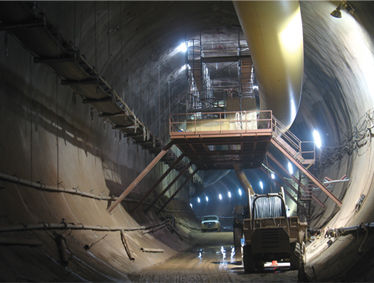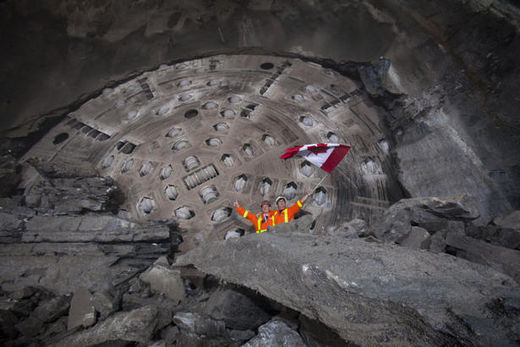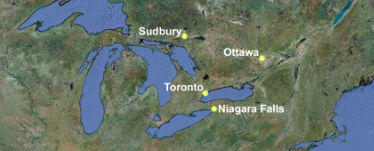
Canada has stepped up its clean power offerings by completing a significant expansion [press release] of its Niagara River hydroelectric power capacity. Stretching 6.3 miles (10.2 km), the tunnel bumps Canada's already substantial 4.4 GW generating capacity upwards by 182.65 MW (~4.2%). And all of that wouldn't have been possible without "Big Becky".
I. Big Becky
Big Becky is a massive tunnel-boring machine (TBM). She gets her name from Sir Adam Beck, a prominent Canadian politician who served in Ontario's Legislative Assembly. Sir Beck was an outspoken advocate of power grids and hydroelectric power and helped oversee the creation of the Queenston Chippawa power station, which was later renamed the Sir Adam Beck Station in his honor. The first station went online in 1922, three years before Sir Beck's death from Anemia (at age 68); a second station, named Sir Adam Beck Station II, went live in 1954.
The Sir Beck plants carried water in a tunnel a mere 1.24 miles (2 km), before depositing it in an open cut, above ground. The new tunnel aimed to be over five times as long. To accomplish that, state of the art excavation techniques would be needed.
The critical component was Big Becky. Weighing 4,000 tons, Becky was the largest hard rock TBM the world had ever seen.
There are several types of TBMs, but hard rock TBMs operate by using rolling discs to create stress fractures in the rock. Loose rock, known as "muck", is

The result of a hard-rock TBM is a smooth tunnel that is typically coated with concrete as a final step, to ensure integrity of the tunnel.
II. The Dig
The unprecedented hydroelectric project didn't come cheaply. The initial budget was set at $985M USD.
But complications arose. Becky unexpectedly hit a patch of soft loose crumbling rock along the planned route. To save the tunnel, the team had to divert Becky along an expensive detour.
The approach worked, at the massive TBM soldiered along, re-routed, towards its destination. As Becky was driven forward by hydraulics, tunnel workers lined the walls of the tunnel with concrete. Becky finally emerged last Friday, breaking out into the air.

By the end of the journey she had chewed through 1.6 million tons of rock -- enough rock to fill even the largest sports stadiums up to the top stands. And she also racked up a $1.6B USD bill -- significantly more than the project planners had hoped for.
III. The Future
The tunnel will go live in 2013.
Already, between 50 and 75 percent of the Niagara River's flow is diverted to hydroelectric projects, so the available flow is limited. The new tunnel will take advantage of the fact that the water will be faster moving than in previous tunnels. It delivers water at 500 cubic metres (17,660 cubic feet) per second, fast enough to fill an Olympic-size swimming pool in seconds.
The finished tunnel measures 47.3 feet (14.4 m) wide -- the equivalent of a four story building, laid on its side. That's big enough to drive large semi trucks or doubly stacked freight trains through.
The new tunnel will send additional flow to the Sir Adam Beck Power Stations. It is expected to produce 1.6 billion kilowatt-hours a year, enough electricity to power approximately 160,000 Ontario homes.
The tunnel is expected to operate for over 100 years (the original tunnel and cut for the first plant is going strong at 90+ years old). Thus the net cost from the construction will be about $0.01 USD per kilowatt-hour. Operations increases may drive up that cost slightly, but considering the Sir Adam Beck Generating Systems are already fully staffed, it seems unlikely it will rise by much.
Despite the seemingly competitive costs, Liberal party Ontario Premier Dalton McGuinty (a premier is similar to a U.S. governor) has been attacked by Conservative leader Tim Hudak about the project. Mr. Hudak has been critical of the Premier's green projects in general, but was particularly scathing about the budget overruns with the tunnel.
But Premier McGuinty urges the public to consider the bigger picture and the cheap power the tunnel will provide. He states, "Yes, some of it has come at a price that hasn't been easy. But neither was it easy for our parents and grandparents to build our original electricity system, to build our schools, to build our roads. But they did it anyway, because they were builders. And so are we."
"When you spread that cost over the 100-year duration of the project, it just doesn't get any better in terms of the kind of power we've got our hands on here. When you compare the options available to us, nothing is easy, nothing is free. It's well worth the investment."
The project created tens of thousands of construction jobs.
According to The Star, a Toronto newspaper, the workers planned to tune out the political bickering and showmanship by celebrating with their own party, which occurred last Friday at the Niagara Falls hall.




I don't find this boring at all!